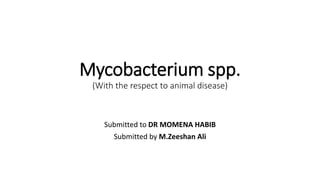
Mycobacterium Spp..pptx
- 1. Mycobacterium spp. (With the respect to animal disease) Submitted to DR MOMENA HABIB Submitted by M.Zeeshan Ali
- 2. Contents • Mycobacterium • Bovine Tuberculosis • Species Affected by M. Bovis • Occurrence/Geographical distribution • Mode of transmission • Incubation Period • Clinical symptoms •Morbidity & mortality •Laboratory diagnosis •Differential diagnosis •Prophylaxis/Control •Vaccine
- 3. Mycobacterium • Mycobacterium species are a group of acid-fast, aerobic, slow- growing bacteria. The genus comprises more than 70 different species, of which about 30 have been associated with human disease (23). The most important species is Mycobacterium tuberculosis, the causative agent of tuberculosis. • Gram-positive, catalase positive, non-motile, non-spore forming rod- shaped bacteria (0.2–0.6 μm wide and 1.0–10 μm long).
- 4. Bovine Tuberculosis • Bovine Tuberculosis (TB) is an infectious disease of cattle. • It is caused by the bacterium Mycobacterium bovis (M. bovis) which can also infect and cause disease in many other mammals including humans, deer, goats, pigs, cats, dogs and badgers. • In cattle, it is mainly a respiratory disease but clinical signs are rare. • This disease is a significant zoonosis that can spread to humans, typically by the inhalation of aerosols or the ingestion of unpasteurized milk.
- 5. Species Affected by M.Bovis • Primary host-cattle • Maintenance hosts • Brush tailed opossums (New Zealand) • Badgers (UK &Ireland) • Bison and elk(Canada) • Kudu and African buffalo (Southern Africa)
- 7. Occurrence/Geographical distribution • Endemic in developing and under-developed cattle rearing countries- Africa, parts of Asia and some middle eastern countries. (RED) • Ongoing Eradication Programs in- UK, USA, NZ, Japan, Mexico, (GREEN) • TB free countries- Australia, Iceland, Denmark, Sweden, Norway, Finland, Austria, Switzerland, Luxembourg, Latvia, Slovakia, Lithuania, Estonia, the Czech Republic, Canada, Singapore, Jamaica, Barbados and Israel. (YELLOW)
- 9. Mode of transmission • ANIMAL-ANIMAL Horizontal Transmission- inhalation of aerosols(cats, badgers), by ingestion(calves, pigs, cats, ferrets), or through breaks in the skin (cats, badgers). Shedding of bacteria in- faces, milk, discharging lesions, saliva, vaginal fluids, semen and urine. (later stages of disease) Close, prolonged contact of healthy animals with infected animal Intensive livestock farming; Extensive livestock farming (vaccination centers, AI Centers, Dipping tanks, Auction markets, transportation, ponds, wells and streams, in tropical areas gathering under shady areas during hot part of the day, salt supplementing points) Vertical transmission Congenital infections (rare in developed countries with an effective eradication program)
- 11. Mode of transmission Animal to human • Pulmonary TB- more in rural dwellers… due to inhalation of infected dust • Gastrointestinal TB- more in urban dwellers… due to ingestion of unpasteurized milk and dairy products • HIV people Human to animal • Rare • Genito-urinary TB… urination in cowsheds/ pasture … animal craving salt would prefer grazing there… INFECTION Human to human • Rare • Less efficient than M. tuberculosis • HIV infected humans are highly susceptible.
- 14. Incubation Period • Takes months to develop • Dormant for years and reactivating during period of stress or old age • 2-5 weeks • Kittens-experimentally IP is 3 weeks.
- 15. Clinical symptoms Humans • A bad cough that lasts 3 weeks or longer. • Pain in the chest. • Coughing up blood or phlegm from deep inside the lungs. • Weakness or feeling very tired. • Losing weight without trying. • Having no appetite. • Chills and fever. • Sweating at night or when sleeping. In Animals • Early on it remains asymptomatic Late stages • Progressive emaciation • a low–grade fluctuating fever • weakness • in appetence
- 16. Clinical symptoms Animals with pulmonary involvement • a moist cough that is worse in the morning, during cold weather or exercise • Dyspnea or tachypnea In the terminal stages, animals may • become extremely emaciated • acute respiratory distress • retropharyngeal or other lymph nodes enlarge and may rupture and drain. • Greatly enlarged lymph nodes can also obstruct blood vessels, airways, or the digestive tract. • If the digestive tract is involved, intermittent diarrhea and constipation may be seen.
- 17. Morbidity & mortality • Infective dose: Cattle: 1 CFU (colony forming units)=6-10 viable bacilli; Human respiratory route: 10’s to 100’s bacteria; Millions by gastrointestinal route • 100% mortality if not treated
- 18. Laboratory Diagnosis • Cattle: Tuberculin skin test (screening test) Microscopic examination of AFB Ziehl/Neelson stain Fluorescent acid-fast stain Isolation on selective culture media (8 weeks) PCR • Biological safety cabinet should be used • Wildlife: Lymphocyte proliferation assay/gamma-interferon assays / ELISA
- 19. Colonies of Mycobacterium Tuberculosis on Lowenstein-jensen medium
- 20. Differential diagnosis • Contagious bovine pleuropneumonia • Pasteurella • Corynebacterium pyogenes pneumonia • Aspiration pneumonia • Traumatic pericarditis • Caseous lymphadenitis • Liver fluke infestation
- 21. Prophylaxis/Control Why control??? • Risk of infection to human • Loss in productivity • Animal market restrictions set by countries with advanced eradication programs • Threat to endangered wild animal species Failure of control programs in developing countries??? • Cannot shoulder the cost of eradication program and compensate for culled animals. • Limited access to education • Poor information networks • Lack of disease surveillance
- 22. Prophylaxis/Control • Mandatory Test-and- slaughter strategy or test- and-segregation. • Periodic re-testing of infected herd • Quarantine • Trace back reactor and those that came in contact with them • Strong Disinfection with 5% phenol, iodine solutions, glutarldehyde and formaldehyde…long contact time • Rodent control • Barrier the area to prevent wildlife interaction with domestic animals • Pasteurization of milk • Awareness about the deleterious effects of unpasteurized milk consumption. • Proper cooking of meat. • Restricted animal movement. • Involvement of ministry of health in coalition with agriculture industry for combined efforts to reduce bovine TB
- 23. Vaccines Human TB • Bacillus Calamite Guerin (BCG) • Attenuated strain of wild type of M.bovis isolate from cattle Bovine TB • BCG vaccination in animals less effective. • Is under consideration in European countries, North America and some African countries.